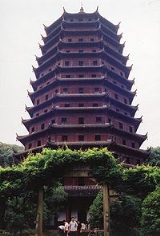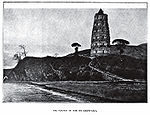
Liuhe Pagoda
Encyclopedia

Pagoda
A pagoda is the general term in the English language for a tiered tower with multiple eaves common in Nepal, India, China, Japan, Korea, Vietnam and other parts of Asia. Some pagodas are used as Taoist houses of worship. Most pagodas were built to have a religious function, most commonly Buddhist,...
in southern Hangzhou
Hangzhou
Hangzhou , formerly transliterated as Hangchow, is the capital and largest city of Zhejiang Province in Eastern China. Governed as a sub-provincial city, and as of 2010, its entire administrative division or prefecture had a registered population of 8.7 million people...
, Zhejiang
Zhejiang
Zhejiang is an eastern coastal province of the People's Republic of China. The word Zhejiang was the old name of the Qiantang River, which passes through Hangzhou, the provincial capital...
province, China
People's Republic of China
China , officially the People's Republic of China , is the most populous country in the world, with over 1.3 billion citizens. Located in East Asia, the country covers approximately 9.6 million square kilometres...
. It is located at the foot of Yuelun Hill, facing the Qiantang River
Qiantang River
The Qiantang River is a southeast Chinese river that originates in the borders of Anhui and Jiangxi provinces and passes through Hangzhou, the capital of Zhejiang province, before flowing into the East China Sea through Hangzhou Bay....
. It was originally constructed in year 970 AD during the Northern Song Dynasty (960 - 1127 AD), destroyed in 1121, and reconstructed fully by 1165, during the Southern Song Dynasty (1127 - 1279 AD).
History and background
The pagoda was originally constructed by the ruler of the Wuyue State, some of which would later makeup Zhejiang province. The name 'Liuhe' comes from the six Buddhist ordinances and it is said that the reason for building the pagoda was to calm the tidal boreTidal bore
A tidal bore is a tidal phenomenon in which the leading edge of the incoming tide forms a wave of water that travel up a river or narrow bay against the direction of the river or bay's current...
of the Qiantang River and as a navigational aid. However, the pagoda was completely destroyed during warfare in the year 1121.

Ming Dynasty
The Ming Dynasty, also Empire of the Great Ming, was the ruling dynasty of China from 1368 to 1644, following the collapse of the Mongol-led Yuan Dynasty. The Ming, "one of the greatest eras of orderly government and social stability in human history", was the last dynasty in China ruled by ethnic...
(1368–1644) and Qing
Qing Dynasty
The Qing Dynasty was the last dynasty of China, ruling from 1644 to 1912 with a brief, abortive restoration in 1917. It was preceded by the Ming Dynasty and followed by the Republic of China....
Dynasties (1644–1911). The pagoda is octagonal in shape and some 59.89 meters (196 feet) in height, it also has the appearance of being a thirteen-story structure, though it only has seven interior stories. There is a spiral staircase leading to the top floor and upon each of the seven ceilings are carved and painted figures including animals, flowers, birds and characters. Each story of the pagoda consists of four elements, the exterior walls, a zigzagged corridor, the interior walls and a small chamber. Viewed from outside, the pagoda appears to be layered-bright on the upper surface and dark underneath. That is a harmonious alternation of light and shade.
According to historian Joseph Needham
Joseph Needham
Noel Joseph Terence Montgomery Needham, CH, FRS, FBA , also known as Li Yuese , was a British scientist, historian and sinologist known for his scientific research and writing on the history of Chinese science. He was elected a fellow of the Royal Society in 1941, and as a fellow of the British...
, the pagoda also served as a lighthouse along the Qiantang River. Being of considerable size and stature, it actually served as a permanent lighthouse
Lighthouse
A lighthouse is a tower, building, or other type of structure designed to emit light from a system of lamps and lenses or, in older times, from a fire, and used as an aid to navigation for maritime pilots at sea or on inland waterways....
from nearly its beginning, to aid sailor
Sailor
A sailor, mariner, or seaman is a person who navigates water-borne vessels or assists in their operation, maintenance, or service. The term can apply to professional mariners, military personnel, and recreational sailors as well as a plethora of other uses...
s in seeking anchor
Anchor
An anchor is a device, normally made of metal, that is used to connect a vessel to the bed of a body of water to prevent the vessel from drifting due to wind or current. The word derives from Latin ancora, which itself comes from the Greek ἄγκυρα .Anchors can either be temporary or permanent...
age for their ships at night (as described in the Hangzhou Fu Zhi).
A small "Pagoda Park" has recently been opened nearby. Its exhibition features models of ancient Chinese pagodas and illustrates the variety of different designs, as well as history, culture and symbols associated with the pagoda.
Source
- Needham, Joseph (1986). Science and Civilization in China: Volume 4, Physics and Physical Technology, Part 3, Civic Engineering and Nautics. Taipei: Caves Books, Ltd.

